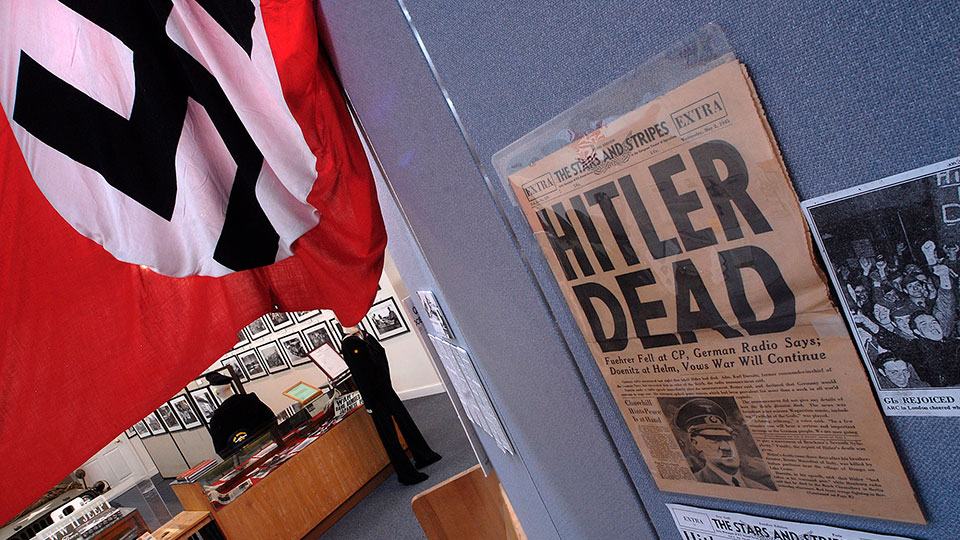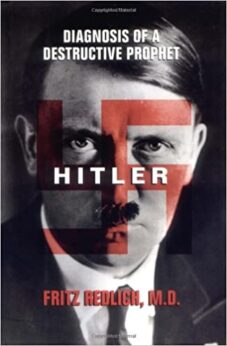
Oy vey! Not another book about Adolf Hitler!! So many books about him have been written, but the study by Dr. Frederick (Fritz) Redlich is special, examining mostly Hitler’s mental and physical illnesses in addition to giving a thorough report of his personal life throughout the course of the Second World War.
It’s not a new book, so why talk about this now? We know that history is not made by “Great Men” (and the occasional women) alone (Caesar, Queen Elizabeth I, Washington, Napoleon, Lenin, Mao, etc.), but that they themselves are shaped by events and circumstances which they seem uniquely capable of exploiting. Yet in the present moment, having barely survived the presidency of a man whose mental condition many have questioned, and at a time when Vladimir Putin appears to have abandoned his famous hard-eyed cool to engage in possibly even a nuclear escalation, it seems like a timely occasion to look back at another strongman still within living memory.
Dr. Redlich, born and raised in Vienna, got his medical degree there and was lucky to escape just before the Anschluss when Hitler invaded Austria in 1938. He rose to the position of dean of the Yale School of Medicine, and after his retirement, moved to Los Angeles and continued working at UCLA.
 It took him many years to write his 466-page Hitler: Diagnosis of a Destructive Prophet because he made many trips to Germany in order to find and interview people who had known Hitler personally. These included his chauffeur, who had almost been Hitler’s friend, the secretary who had not given any interviews for 50 years, and other people he could still find alive. The book was published in 1999 by Oxford University Press.
It took him many years to write his 466-page Hitler: Diagnosis of a Destructive Prophet because he made many trips to Germany in order to find and interview people who had known Hitler personally. These included his chauffeur, who had almost been Hitler’s friend, the secretary who had not given any interviews for 50 years, and other people he could still find alive. The book was published in 1999 by Oxford University Press.
In 2001 he went back to New Haven, where many of his old friends were living in a senior home, partially because his wife Herta Glatz, an opera singer to whom he was married for over 50 years, needed special care for Alzheimer’s disease. He died on Jan. 1, 2004.
Adolf Hitler came from a troubled family with a history of mental illness and incest. His father was a customs official but was said to have been “blind” toward smugglers and so became fairly wealthy. His mother, a niece of his father, was his third wife, after having served in his house as a maid. She was illiterate and probably not very bright. She allowed her son Adolf to leave school completely in 6th grade because he malingered to have tuberculosis. He spent his first years of adolescence in bed at home.
The father, Alois Schicklgruber, changed his name to Alois Hiedler (pron. heed-ler), Schicklgruber not being a very elegant-sounding name. Later, in Munich, Adolf changed his name again to Hitler which sounds much harder and more Germanic. He also changed his nationality to German, in order to escape the military draft in Austria. After his mother’s death in 1907, when he was in his late teens, he moved to Vienna, where he had initially enough money from an inheritance to live a good life. But soon he had spent all his money and had to move into a shelter for homeless men. It was there that he developed his hatred of poor Jewish and Slavic immigrants from other parts of the Austro-Hungarian Empire.
After he had become rich again from his political activities in ultra-right-wing proto-fascist politics, he moved back to Munich, where he continued his political activities and discovered his talent as a speaker and actor. His underwriters in big business believed they could “use” a person like him to sow chaos and disinformation, to be replaced or cast aside when he no longer served their purposes.
As a typical borderline personality, Adolf Hitler malingered early on many different illnesses. The truth is, as Dr. Redlich found out after studying all available medical reports, that Hitler did indeed suffer from poor health, beginning with very bad teeth due to his almost exclusive diet of Austrian sweets. He also had irritable bowel syndrome (chronic constipation, spasms in the abdomen) as a result of his unhealthy diet. Early on he had moderate hypertension with headaches and tinnitus. He also had early arteriosclerosis (again, probably connected to his unhealthy eating habits) with enlargement of his left heart. In Munich, he consulted with Dr. Theodor Morell, a quack without any medical skills. This doctor treated Hitler early on with a combination of some 14 drugs, mostly by injection. He gave him a shot of amphetamines and caffeine each morning because Hitler, as a typical sociopath, liked to party until late into the night and was not eager to get up in the morning.
Around 1941 his medical condition declined, and he complained to Dr. Morell as feeling “badly, worse than ever before.” His EKG showed some myocardial damage. Dr. Morell gave him a concoction of laxatives, opioids, anticoagulants, belladonna (atropine), papaverine as a muscle relaxant, barbiturates for sleep, and massive doses of male and female hormones. Any medical doctor who prescribed this combination of dangerous medications today would lose their license overnight. Dr. Morell was not discarded until 1945, was arrested by the U.S. military, and sentenced to jail in Nuremberg, where he died in 1948.
By 1942 Hitler’s condition had deteriorated to permanent severe headaches, impairment of his vision, more severe insomnia, and swollen temporal arteries. These are the symptoms of “temporal arteritis,” which in his case expanded to all the arteries of his body. This disease causes all the arteries to develop thickened walls, an inflammatory process, and constricted lumina of the arteries, which can bring less oxygen-rich blood to the entire body, thereby causing multiple small infarctions in every organ with accompanying pain.
Hitler was a very sick man by the following year, with beginning Parkinson’s disease. He gave the impression of a tired, old man. Dr. Morell treated him with coli bacteria from his own stool! His headaches were diagnosed to be sinus-related and were treated with cocaine solution! His Parkinson’s was treated with atropine!
In 1945, when the Soviets had one and a half million soldiers standing around Berlin, Hitler clearly became delusional (typical for the borderline under stress), claiming that the Soviets would suffer their greatest, bloodiest defeat ever in their history.
On April 30, at the age of 56, he committed suicide together with his mistress Eva Braun, because “the German people did not deserve a savior like him.” His political testament shows his delusional fanaticism: He claimed that he was not responsible for the war, but that the Jews had started it for Jewish interests: “the Jews” were responsible for the deaths of millions of Europeans and would have to pay for it.
His suicide was a “heroic act” only because he did not want to fall into the hands of the Jews. His choice of April 30 for his suicide meant he would not have to live to see another May Day. He was convinced that there would be a rebirth of the National Socialist movement. He obligated his followers to continue the fight against “International Jewry” and to fight to their deaths.
Sometimes one can only wonder whether there was not a grain of truth in his last written words contemplating the rebirth of many fascist parties and dictatorships. For if these larger-than-life figures who stride across the world stage at given moments are not themselves the chief drivers of history, what can be said about those who, wittingly or not, consciously or not, act out their will? Surely, they too must face accountability, no?










